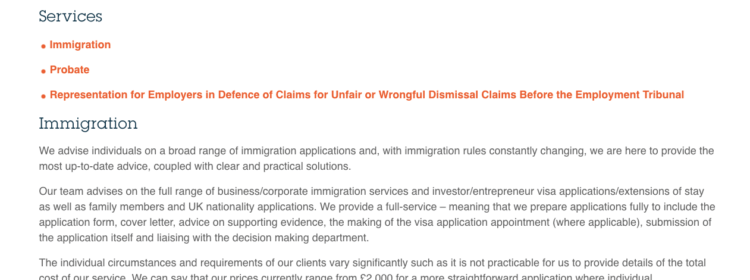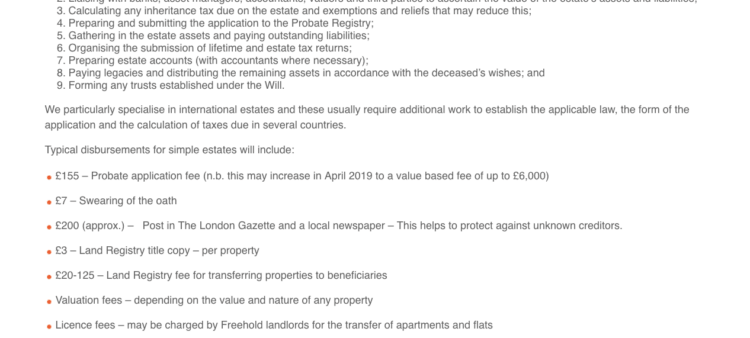As a legal professional, clear communication is essential to the success of your practice—especially when it comes to your interactions with clients (and potential clients). It makes sense, then, that the industry has introduced new price transparency rules for the practice of some types of law.
If you haven’t done so already, it’s time to start displaying pricing on your firm’s website (or at least take a second look at how you’re doing this).
Under the Solicitors Regulation Authority (SRA)’s new price transparency rules for law firms (which came into effect in December of 2018), your firm must meet requirements for publishing your prices for legal services if you practice certain types of law. Among other things, you’ll also need to clarify what’s included for quoted prices, and provide timelines for the services provided.
For many law firms, meeting the SRA’s new pricing rules means making changes and updates to how they provide their prices and service information—but there’s no need to be overwhelmed! Staying compliant is more straightforward than you’d think, and clarity on pricing is a positive for both you and your clients.
By understanding what’s expected of you and your firm, you can help ensure compliance under the new SRA rules, with the bonus benefit of promoting better client relationships through enhanced transparency for people considering purchasing legal services. According to the SRA’s Ethics guidance, costs are at the heart of one quarter of all complaints dealt with by the Legal Ombudsman. By being clear about pricing from the start, you can reduce confusion (and complaints) in the future.
This guide will provide an overview of the new SRA price transparency rules, and who the rules effect—while also offering tips to stay compliant in the most efficient way possible.
When do the SRA Price Transparency rules apply?
At their core, the new SRA price transparency rules are about just that—transparency.
Basically, you are required to clearly display price and service information if you work in certain areas of the law, which include:
For individuals:
- Residential conveyancing (Freehold sale or purchase, leasehold sale or purchase, mortgages, and re-mortgages)
- Probate (uncontested cases with all assets in the UK)
- Motoring offences (summary only offences)
- Employment tribunals (claims for unfair or wrongful dismissal)
- Immigration (excluding asylum applications)
For businesses:
- Debt recovery (up to £100,000)
- Employment tribunals (defending claims for unfair or wrongful dismissal)
- Licensing applications for business premises (new applications or varying existing licenses)
What are the new rules?
In order to stay compliant with the SRA price transparency rules for services provided in specified areas of the law, you must generally do three things:
- Display your prices
- Explain what services you offer (and the qualifications of you and your team providing the services)
- Ensure that these details are published or available in a clear format for clients
1. Display your prices
The first element of the new SRA rules focuses on making your costing details available so that clients can get a reasonable, easy-to-understand picture of what they may need to spend to take advantage of a service
If you cannot provide a total cost for a legal service, you must provide an average or range of costs.
The rules offer some leniency for the way you list these costs: There’s no need to include a binding quote for every single scenario you might possibly deal with. Instead, you can publish an average cost for your service—and “average” can mean your typical cost for a service, or the mathematical median of costs for cases of that type at your firm, whichever is easiest.
When displaying your pricing under SRA price transparency rules, you should also be sure to:
- Detail the basis of your charges (including any hourly rate or fixed fees—Clio’s invoicing and billing features can be helpful with this)
- Highlight any likely disbursements (and their costs)
- Explain whether VAT is included (or not)
- Explain when clients may have to make payments for conditional or damage-based fees
It’s important to note that the SRA rules do not determine what your prices should be in these circumstances—rather, they insist that you make your prices, whatever they may be, clear and available to potential clients.
2. Detail what’s included in services (and who’s providing them)
To stay SRA-compliant, you also must follow certain rules for describing service information. Just as with the pricing rules, it’s important to provide as much transparency as possible, giving your clients the clearest understanding of what they can expect from your legal services.
Specifically, you must offer service information that:
- Explains exactly what services are included in a quoted price—and highlights any services that are not included in the price (that a client may reasonably expect to be).
- Provides information on key stages and timelines for services.
You must also publish details about the providers of these services, including:
- The qualifications and experience of anyone that carries out the work of these services.
- The qualifications and experience of the supervisors of anyone that carries out services.
For example, law firm Osborne and Clarke clearly lists the areas where it provides services, with descriptions of what it provides:

And clearly displays pricing, either directly on this page or on another, easily accessible page:

3. Publish or provide pricing and service information clearly
Once you’ve sat down and determined the pricing and services information that your firm can provide for clients, you need to ensure that it’s published in a clear, easy-to-find, and easily readable format. It’s not enough to just have the numbers listed; to be truly transparent (and compliant), clients should be able to reasonably access your prices and service details without having to provide personal information (such as email addresses or phone numbers).
You can do this in two ways. Ensure pricing and service details are:
- Published prominently (with as much detail as possible) on your website, or,
- Made available in other formats (such as a detailed quote)
Tip: The SRA provides a number of templates for service/pricing models that can be useful when determining how to best display information.
You may like these posts
Publishing pricing details on your website
When publishing pricing and service details on your website, it’s essential to be clear so that potential customers can get the best possible information with ease. In addition to providing the mandatory pricing and service details outlined earlier, you may want to review how you display information on your website for the following factors.
- Use plain language. Avoid using unnecessary technical or legal jargon or overly complicated wording.
- Link to (reputable) sources for further explanation about key stages of a matter. Be sure to take reasonable steps to verify the accuracy of sources you link to.
- Provide examples of typical clients or transactions your firm has experience with. This can make it easier for a potential client to see where your services may help them—but be sure not to disclose any confidential or identifying information.
- Consider other languages. If possible, and depending on your practice area and clients, it might be worth including details in languages other than English.
Using other formats and quotes for pricing
If your website isn’t a reasonable place to publish your pricing details—or if your firm doesn’t have a website—you can still stay compliant with SRA transparency rules. The key is to be able to quickly produce a quote that includes all the necessary details for clients, upon request.
Tech can make this process easier. Using Clio can take some of the stress and time-consuming labour out of generating a quote. While manually creating a transparent quote for your fees can be time consuming (which could in turn potentially leave a client waiting—going against the SRA guidelines), in Clio, you can predefine all your fees. With your fees predefined, you can generate a quote in seconds and share it with your client quickly and easily—helping you stay compliant with SRA rules.
Using a client portal like Clio Connect may can the process of secure communication even easier if you firm does not have a website.
Even if you do have your prices listed on your website, having your fees predefined in Clio can also help you stay compliant in certain more complex cases. For example, if you’re in a bind to get detailed pricing information to a potential client, you may be able to generate an invoice in Clio; using that as a quote can help provide your client with detailed information about your services and their costs.
Understanding and following the SRA price transparency guidelines for law firms is not just mandatory—it’s also beneficial to both you and your clients. By giving your clients the best possible indication of what it costs to carry out legal services, you’re able to build stronger client relationships and foster more satisfying client experiences.
Note: The information in this article applies only to practices in England and Wales. This post is provided for informational purposes only. It does not constitute legal or business advice.
We published this blog post in March 2019. Last updated: .
Categorized in: Legal Accounting





